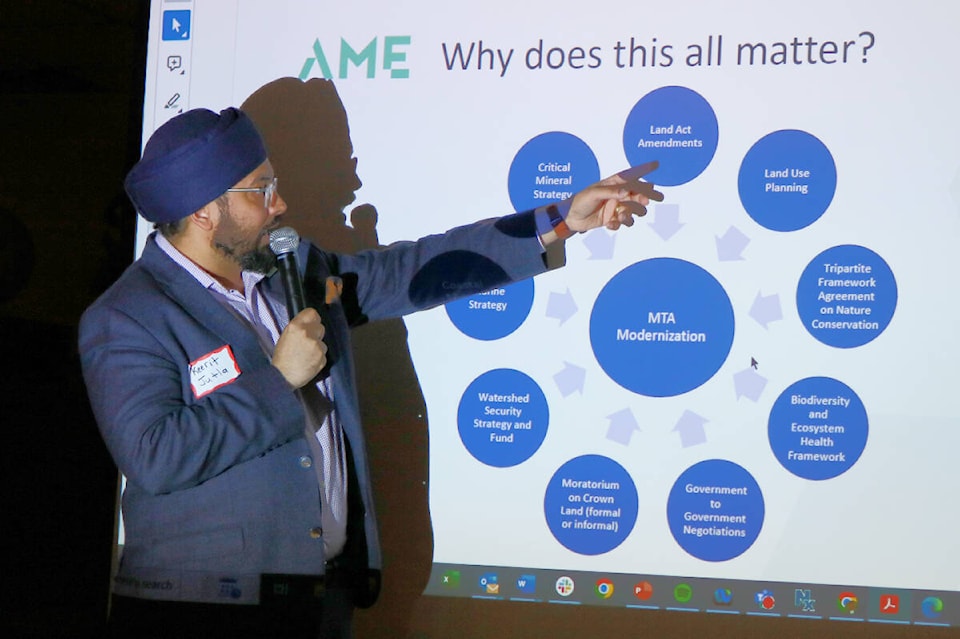The president of B.C.’s Association for Mineral Exploration (AME) says a pause on changes to the province’s Land Act is a welcome step toward providing the regulatory certainty industry is looking for.
Keerit Jutla was at the Smithers Exploration Group’s (SEG) Rock Talk in Smithers when Nathan Cullen, minister of Water, Land and Resource Stewardship announced his government would not go ahead with amendments to the Act following months of criticism of the consultation process.
Jutla pivoted his presentation slightly at the annual exploration conference to announce what Cullen had told him just about an hour before he was scheduled to speak. He assured conference attendees the move is an opportunity to create stability for all stakeholders.
“My background is I practiced regulatory law and Aboriginal law for about 10 years in Alberta and B.C. and I work with proponents, work with [First] Nations and I have a strong passion for economic reconciliation and DRIPA and Canada’s natural resource economy,” he said.
“We all desire and we all are going in the same direction and I think the key thing is just how do we ensure we have a process that collects all of our collective information the right way, so we can build things that work for everyone.”
Getting it right, he said, is critical for industry, particularly the smaller players, such as junior exploration companies, who rely on access to capital markets and are easily spooked by regulatory uncertainty.
“There [are] still some difficulties for capital markets access for many juniors in B.C., and that’s something that we don’t want to see is the risk of capital markets freezing out because of regulatory uncertainty,” he said.
Proposed Land Act amendments were intended to bring legislation in line with B.C.’s Declaration on the Rights of Indigenous Peoples Act (DRIPA), something Cullen said was supported by the Legislature, but alienated others.
“But this touched a nerve and a moment in time that we now recognize,” Cullen said at a hastily arranged news conference at the legislature Feb. 21. “The responsible thing for government to do is listen.”
For its part, AME felt the industry had been left hanging by the process and commended Cullen and the government for taking a step back.
“I think all of us need to be very mindful that we, in order to get into the direction that everyone wants to go, we just need to ensure that we take the time and take the due diligence to do it in a way that doesn’t create uncertainty,” Jutla said.
Mineral exploration spending has been on an upward trend for several years. In 2022, the last year for which data is available, investment reached a 10-year high of $740 million.
The lion’s share of that investment, 61 per cent, was made in Northwest B.C. where Jutla said the grassroots work of economic reconciliation is taking place. He noted 21 per cent of 2022 spending went to Indigenous-associated businesses.
“Natural resource development and mineral exploration and mining is very important for communities like Smithers, Terrace, Kamloops, Cranbrook,” Jutla said. “And it’s not just the industry, it’s the associated value chain of service companies that are working with it. And these are the companies and folks that are supportive [of] and are working in reconciliation.”
READ MORE: B.C. presses pause on Indigenous-related changes to the Land Act
The Land Act is not the only uncertainty facing the industry, however. In September 2023, the B.C. Supreme Court ruled the province must consult First Nations before mineral claims are registered on their territories following a suit by the Gitxaala First Nation near Prince Rupert.
The Court gave the province 18 months to modernize the Mineral Tenures Act (MTA) in consultation with First Nations and Industry.
Jutla said the commitment to consultation shown by the pause in the Land Act amendment process also bodes well for industry having a seat at the table in rebuilding the MTA.
“I think this sets the good stage for… how do we build a Mineral Tenure Act process?” he said. “And how do we build a staking process pursuant to the court decision that works for everyone? Our members, obviously, for their livelihood, it’s their intellectual property for what they’re doing, for their ability to explore, but also respecting Indigenous rights. So we’ve just got to make sure now we all come together to build a system that works for everyone.”
Chris Ogryzlo, a director on the Smithers Exploration Group board and one of the perennial organizers of Smithers Rock Talk, said there was relief in the room when Jutla announced what Cullen had told him by telephone about an hour before his presentation to the conference.
She said the process created a lot of uncertainty in the industry and conference attendees — which annually includes representatives of the biggest players such as Newmont Mining right down to individual independent prospectors — responded positively to the prospect of more in-depth and inclusive consultation.
“People just need to know what the playing field is in British Columbia and are concerned, of course, because capital is hard to come in the current climate,” she said. “So, yeah, they were pleased that the minister decided to move in that direction.”
Consultation had been scheduled for completion by the end of March. Cullen gave no timeline for the resumption of the process nor eventual amendment of the Act.
- With files from Wolfgang Depner
